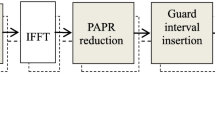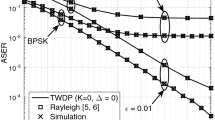Abstract
Multiple-input–multiple-output orthogonal frequency division multiplexing (MIMO–OFDM) is a promising 4G technology to increase data rate and capacity of a system. Further, the space–frequency-block-coding (SFBC) technique in MIMO–OFDM system has increased reliability of system in high mobility channels. Fourier transform in conventional OFDM system can obtain either in time or frequency domain, hence it can be acceptable to reduce inter-carrier-interference while it fails for doubly dispersive channels where both the domain are changing simultaneously. Another mathematical tool named as fractional Fourier transform (FrFT) cancels the effect of rapidly varying time–frequency-distortions by considering new rotating axis \(\left( {u,v} \right)\) at an angle \(\alpha\) from conventional time–frequency plane. In this paper, the performance of SFBC encoded MIMO OFDM system using FrFT in place of FFT has been analyzed under two-wave-diffused-power (TWDP) frequency selective fading channel. In this paper, the novel closed form expression for average bit-error-rate (BER) for coded and un-coded FrFT based MIMO–OFDM system under TWDP has also been presented in this paper. The results carried out using simulation shows that the proposed model achieves BER of 10−2 at 5 dB SNR whereas conventional achieves the same at 14 dB hence, concluded that the novel system performance improved by nearly 9 dB.




Similar content being viewed by others
References
Bauch G. (2003). Space–time block codes versus space–frequency block codes. In IEEE (pp. 567–571).
Gupta, B., & Saini, D. S. (2013). Space–time/space–frequency/space–time–frequency block coded MIMO–OFDM system with equalizers in quasi static mobile radio channels using higher tap order. Wireless Personal Communications, 69(4), 1947–1968.
Almeida, L. B. (1994). The fractional Fourier transform and time-frequency representations. IEEE Transaction of Signal Processing, 42(11), 3084–3091.
Kumari, S. (2013). Exact BER analysis of FRFT-OFDM system over frequency selective Rayleigh fading channel with CFO. Electronics Letters, 49(20), 1299–1301.
Chen, E., Tao, R., & Meng, X. (2006). The OFDM system based on the fractional Fourier transform. In Innovative computing, information and control, ICICIC’06, first international conference on IEEE (vol. 3, pp. 14–17.
Wang, H., & Ma, H. (2010). MIMO OFDM systems based on the optimal fractional Fourier transform. Wireless Personal Communications, 55(2), 265–272.
Torabi, M., Aissa, S., & Soleymani, M. R. (2007). On the BER performance of space–frequency block coded OFDM systems in fading MIMO channels. IEEE Transactions on Wireless Communications, 6(4), 1366–1373.
Durgin, G. D., Rappaport, T. S., & De Wolf, D. A. (2002). New analytical models and probability density functions for fading in wireless communications. IEEE Transactions on Communications, 50(6), 1005–1015.
Bauch, G. (2003). Space–time block codes versus space–frequency block codes. Vehicular Technology Conference, 1, 567–571.
Alamouti, S. M. (1998). A simple transmit diversity technique for wireless communications. IEEE Journal on Select Areas in Communications, 16(8), 1451–1458.
Shi, L., Zhang, W., & Xia, X. G. (2013). Space–frequency codes for MIMO–OFDM systems with partial interference cancellation group decoding. IEEE Transactions on Communications, 61(8), 3270–3280.
Martone, M. (2001). A multicarrier system based on the fractional Fourier transform for time–frequency-selective channels. IEEE Transactions on Communications, 49(6), 1011–1020.
Singh, K., Saxena, R., & Kumar, S. (2013). Caputo-based fractional derivative in fractional Fourier transform domain. IEEE Journal on Emerging and Selected Topics in Circuits and Systems, 3(3), 330–337.
Zheng, J., & Wang, Z. (2010). ICI analysis for FRFT–OFDM systems to frequency offset in time–frequency selective fading channels. IEEE Communications Letters, 14(10), 888–890.
Papantoniou, S. J. (1992). A multipath channel model for mobile-radio communications. In Personal, indoor and mobile radio communications (pp. 92–97).
Saberali, S. A., & Beaulieu, N. C. (2013). New expressions for TWDP fading statistics. IEEE Wireless Communications Letters, 2(6), 643–646.
Singh, A. K., & Saxena, R. (2010). Development of convolution theorem in FRFT domain. In Signal processing and communications (SPCOM), international conference on IEEE (pp. 1–3).
Zayed, A. I. (1998). A convolution and product theorem for the fractional Fourier transform. IEEE Signal Processing Letters, 5(4), 101–103.
Singh, D., & Joshi, H. D. (2016). BER performance of SFBC OFDM system over TWDP fading channel. IEEE Communications Letters, 20(12), 2426–2429.
Gradshteyn, I. S., & Ryzhik, I. M. (2014). Table of integrals, series, and products. Cambridge: Academic Press.
Author information
Authors and Affiliations
Corresponding author
Additional information
Publisher's Note
Springer Nature remains neutral with regard to jurisdictional claims in published maps and institutional affiliations.
Rights and permissions
About this article
Cite this article
Chawla, T., Kansal, A. Performance Evaluation of SFBC MIMO–OFDM Using FrFT Under TWDP Fading Channel. Wireless Pers Commun 104, 1121–1131 (2019). https://doi.org/10.1007/s11277-018-6072-z
Published:
Issue Date:
DOI: https://doi.org/10.1007/s11277-018-6072-z




